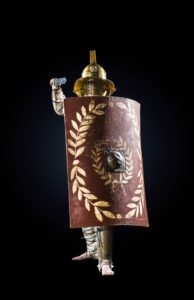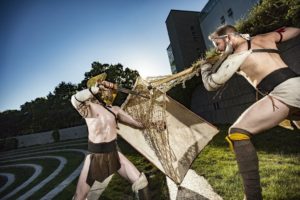
The gear in The Wyrm and the Maiden Grim
Helmet
Soldiers in the late
The nasal guard shown in the picture was updated before the film, but for some
Mail
The short-sleeved mail shirt was worn by Roman soldiers already in the 3rd century. Since then the model spread all around Europe. Mail is the only known armour type used by Vikings. The reproduction Arttu wears in the film is made in India and has relatively large rings. Most historical
Shield
The shield we used is not a precise copy of any particular shield, but follows the overall standards of round center grip shield of the time. It’s 80 cm wide, 6mm thick, and the boss is around 2mm thick. For this movie we made the shield from plywood, but original shields were made of planks (and not out of any planks but split wood planks that are a bit different than your local hardware stores ones). Shields also get thinner towards the edges. At the very edge of the shield is about 3mm thick. Shields were most likely covered with rawhide, linen covering is hypothetical at best. Joeli painted the wyrm in this shield modeling Viking age art, but adding a smile for the wyrm as an original twist.
The important point about plank shields is that sharp weapons cut into them much easier than they cut into plywood. We compensated these differences in the choreography with skill and knowledge.
Small spearhead and butt piece
The butt piece was a mistake. The earliest found counter weight in spears in Scandinavia is from 12th century. Leaf shaped heads seem to go out of fashion by 950 CE, but it is also suggested that a few leaf shaped heads may have continued in use throughout the Viking age.
Balancing spears can also be done by shaping the shaft thinning towards the spearhead. This is considerably more affordable method for men of the 10th century. The drawback is that designing the spear so that the counterweight works, reduces one’s ability to throw it. There are mentions in the sagas of men fighting with spear and shield, which seems to be the predominant way of fighting in the Viking age. It doesn’t seem unreasonable to think you would make a spear shaft for that purpose.
Large spearhead
The spearhead Joeli is using is close to Jan Petersen’s type F, dating it to 825–950 CE.
We attached it to a long ash shaft and we see it as a cutting tool as well as a tool to thrust. With a heavy ash pole it is also a bone breaker if not like a quarterstaff, but good enough. Both shafts we use for spears in this movie are purely hypothetical. The only ever found shaft for a viking age spear is in the picture.
Seax
A local multi-tool of iron age design as found around the shores of the Gulf of Finland. 35 cm, 320 g. Joeli made the handle roughly according to a 1200-year old bronze example. This time from ash, walnut, hide, beeswax and iron pigment.
The handle is super nice to use. It’s again hypothetical to put this handle in this blade, but so would be any other handle.
We thought to arm the travelling warrior with a blade that is as much of a tool than it is a weapon since a traveller would need one.
Image credits
- The original shield pictured here is currently in the historic museum of Oslo. Mail has that same adress.
- https://secretsoftheice.com/news/2017/11/29/spear/
- http://sagy.vikingove.cz/scandinavian-helmets-of-the-10th-century/#middle
- http://www.vikingage.org/wiki/wiki/Spears
- http://warfare.gq/6C-11C/Exultet_beneventano-Lombards-10C.htm?i=1
- http://www.angelfire.com/wy/svenskildbiter/armsandarmour/mailshrt.html
- https://destinationsigtuna.se/en/partner/sigtuna-museum/

 s to the gladiators.
s to the gladiators.